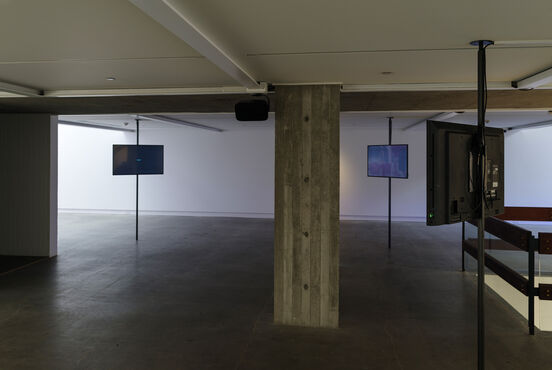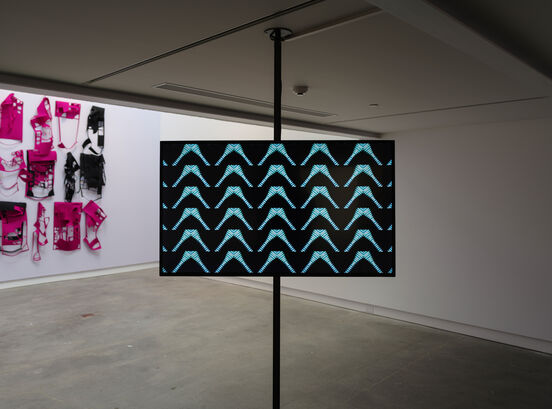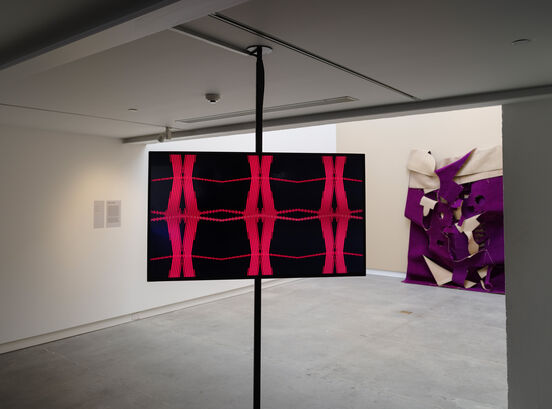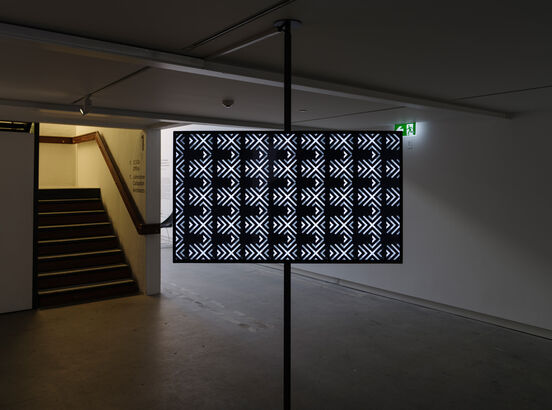-
Author
Hūfanga-He-Ako-Moe-Lotu Professor ‘Ōkusitino Māhina & Kolokesa Uafā Māhina-Tuai -
Date
1 Feb 2022
Essay
Toro Whakaara: Sione Faletu
As a huge expanse of ocean, the moana was far from peaceful, the connotation implied by ‘Pacific’. Moana was in fact a place of connection, separation and intersection; of life and death, nourishment and malnourishment. Moana navigators and fishermen were generally called tautai (warriors of the sea)¹ or kaivai (eaters of water),² terms which evoke imagery of a permanent war waged against the elements and a constant state of oneness with waves and winds through effective knowledge and skills. These names point to Moana as a place that both connects and separates – that is, intersects – rather than a space that only connects.³
The moana as a place that intersects fortune and tragedy, life and death, nourishment and malnourishment is what connects and separates two historical maritime tragedies that Sione Faletau explores in his work. Interested in the fine balance that is essential between nature, human experiences and built environments, both tragedies involved a war against the elements where lives were lost. The shipwreck of HMS Orpheus in 1863 is Aotearoa’s worst maritime disaster, and the tragedy of the Tuaikaepau (‘Slow-but-sure’) in 1962 motivated the Tongan survivors to initiate a self-rescue mission, using their knowledge and ingenuity, that eventuated in their rescue. Faletau investigates these two events through a Tongan lens. He utilises the Tongan concept and practice of hoa, inseparable pairs of equal and opposite binaries, within and across his process of thinking, feeling and doing. This in turn critiques the term ‘hostile architecture’ in privileging human experiences and built environments over nature, as opposed to one where their mediation and liberation is predominant.
History is logically made up of events in the past, placed in the front of people as guidance, and upon which the future is brought to bear, guided by past refined knowledge and experiences, where the illusive past and elusive future are constantly negotiated in the ever-changing present. Faletau’s process of placing the past historical actualities of two maritime tragedies in front as guidance for the future possibilities of his work is a reminder that nature always prevails if the intersection of the hoa pair relationship is not mediated in more balanced and liberated ways of knowing, sensing and doing. From a Tongan lens, when both ways of nature and ways of people are considered and mediated through sustained symmetry, harmony and beauty, ‘hostile architecture’ can be transformed from a condition of crisis/hostility to a state of stasis/stability.
Faletau’s work delves further into the Tongan deep past to utilise the concept of ongo, meaning sound, hearing and feeling which in turn is connected to loto meaning inside, desire and heart. In Tongan philosophical conception and action, it is in the nature of the ‘uto brain and the fatu/mafu heart to respectively ‘ilo know through the ‘atamai mind and fakakaukau thinking and to ongo feel in terms of ongo feeling and loto desire, the qualities (and quantities) of things, events or states of affairs out there in ‘iai reality as in nature, mind and society. Ongo sound as a natural entity is ‘ilo‘i known by the ‘atamai mind and fakakaukau thinking in the ‘uto brain and both ongo‘i heard and felt by both the ear and heart as physical and bodily entities.⁴
Taking on the role of a tā-vā time-space mediator/ intersector of kohi lines and vā spaces, Faletau has captured present-day sounds as nature-given and man-made entities, from the Manukau Heads. These are combined with sounds of the past. The sung and danced poem of tragedy titled ‘Tuaikaepau’ was composed by Queen Sālote, with music and dance by Noble Ve‘ehala (Leilua) and Malukava (Tēvita Kavaefiafi), in 1962, to commemorate the courageous feat of the survivors.⁵ In Faletau’s work, the ongo fakafa‘ahikehe minor sound of the fangufangu nose-flute⁶ plays the first two verses of a 25-verse-long voyaging sung and danced poetry called Me‘etu‘upaki.
The first two verses of the Me‘etu‘upaki are prayers to the gods of peau/ngalu waves or tahi sea and matangi winds, Lulu and Lātū, for divine protection and favourable voyaging conditions. The remaining verses articulate the knowledge and skills of our ancestors to have traversed the great moana from Kiribati and Tuvalu, through Futuna and ‘Uvea, Sāmoa and Fiji to Tonga where they celebrated their safe voyage with kava, singing and dancing. A reminder that the intersection with nature is always considered in relation to our human experiences and built environments in a more harmonious way, making the term ‘hostile architecture’ redundant from a Tongan lens. Such a movement from the hectic to the static is deeply embedded in the Tongan (and Moanan Oceanian⁷) tāvāist society-ecology concept and practice fonua (honua, hanua, vanua, fanua, fenua, enua and whenua), where the intersection or connection and separation between people and their environment as an inseparable hoa pair are constantly checked and balanced as both process and outcome.
Tongan ‘aati arts can be defined as the cyclical temporal-spatial, formal-substantial and practicalfunctional transformation of subject matters in the creative process through sustained tatau symmetry and potupotutatau harmony to produce mālie/faka‘ofo‘ofa beauty/quality. Tongan arts are divided into three genres: faiva performance, tufunga material and nimamea‘a fine arts.⁸ Faletau is a tufunga tāongo and tufunga tākupesi, material artist of sound, manipulating/making and digital drawing/designing. He is a digital intersector of ongo-vā sound-space by means of kohi-vā lines-spaces. His work is rooted in the foundations of his Tongan deep past (in the front), while brokering new hala/tala pathways into the distant future (in the back), both in the ever-changing present. This is the depth and breadth of Sione Faletau’s refined contribution to the continuum of Tongan arts.
1. The word toutai is a variation of tautai and tautai a variation of tautahi, which evokes and invokes a heliaki, ‘metaphorically saying one thing but historically meaning another’ of ‘waging war against the sea’ or ‘being at one with the sea’.
2. The word kaivai, literally meaning ‘eaters of water’, is a metaphor for ‘what people are good at or knows best’, i.e., ‘knowledgeable and skilful in’, as in navigation involving both the waves and winds.
3. Hūfanga ‘Ōkusitino Māhina, ‘Pulotu, Hawaiki and Lapita’, in K. Chitham, K. U. Māhina-Tuai, and D. Skinner, Crafting Aotearoa: A Cultural History of Making in New Zealand and the Wider Moana Oceania, Te Papa Press, 2019.
4. Ongo sound, like light, waves or winds, is merely a vaka vessel/medium/vehicle of energy as matter, i.e., tā time and vā space. This is evident in mana ‘uhila thunder and lightning as vaka of energy which travels by way of mata eyes and/or ava holes in spiral-type, vortex-like formation.
5. The ‘Tuaikaepau’ song was sung by the Kava Tonga Vocal Choral Musical group in 1962, but Sione Faletau has used the version sung by the Afokoula group in his work.
6. Meleseini Haitelenisia Fifita ‘O Lakepa Lolohea Fetu‘u Tuai, tā/ifi fangufangu nose-flutist, recorded on 27 July 2021.
7. For background to the name ‘Moanan Oceanian’/Moana Oceania and why it is used by the two authors over the problematic and imposed name ‘Pacific’, see: https://www.lagi-maama.com/whymoanaoceania
8. For more information on Tongan arts, see: https://www.tetaumatatoiaiwi. org.nz/moana-oceania-tonga/
—
Sione Faletau is a multidisciplinary artist of Tongan heritage based in Ōtara, Tāmaki Makaurau Auckland. He is a graduate of the University of Auckland Elam School of Fine Arts with a Bachelor of Fine Arts with First-Class Honours and Master of Fine Arts with First-Class Honours and is a current doctoral candidate completing his Doctor of Fine Arts degree. Faletau’s current research and art practice centres around Tongan masculinity from an Indigenous perspective. Working with sound, he extracts the audio wave spectrum from found songs and video footage; this information or data gives him material he can use to manipulate into kupesi (patterns).
Hūfanga-He-Ako-Moe-Lotu Professor ‘Ōkusitino Māhina is Professor of Tongan Philosophy, Anthropology, and Aesthetics at Vava‘u Academy, Vava‘u, Kingdom of Tonga & Vā Moana: Space and Relationality in Pacific Thought and Identity, Marsden Research Cluster, Auckland University of Technology, Tāmaki Makaurau, Aotearoa. He has taught Moana Oceania political economy and aesthetics for some 25 years at the University of Auckland, Massey University and ‘Atenisi University, and has published extensively in these areas as well as writing and publishing Tongan poetry.
Author and curator Kolokesa Uafā Māhina-Tuai together with Toluma‘anave Barbara Makuati-Afitu are co-founders of cultural organisation Lagi-Maama Academy & Consultancy
—
This text is republished from Toro Whakaara: Responses to our built environment, a publication produced by Objectspace to accompany an exhibition of the same name. The publication is edited by Tessa Forde, and copy-edited by Anna Hodge.

(above and below) Installation views of Sione Faletau's Kupesi Peau Ongo in Toro Whakaara at CoCA Toi Moroki. Photographs by John Collie.


